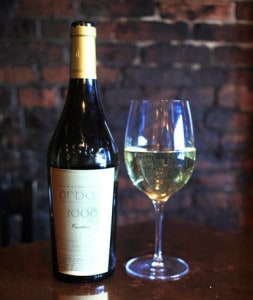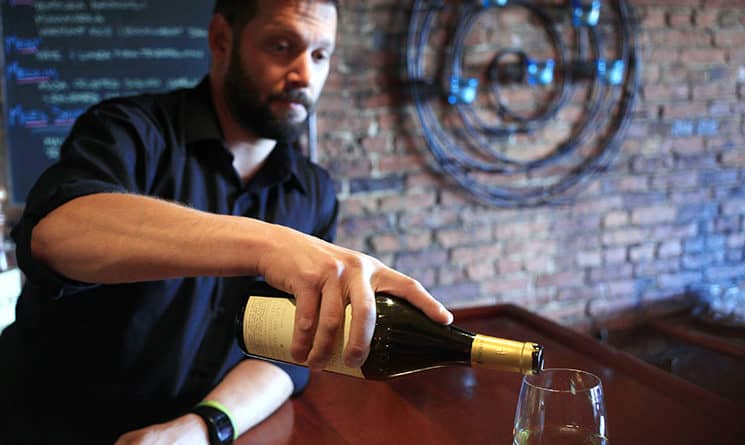Orange wines are a new concept to the restaurants of the Seacoast, but not to the greater wine community. Orange, or oxidative wines have been growing in popularity among trendsetting sommeliers and more outlandish vintners.
Evan Mallett, chef and owner of the Black Trumpet Bistro in Portsmouth, recently held an impromptu wine tasting with two former staff members, R.J. Joyce and James Woodhouse, owners of Gigi’s in York and the soon-to-open Louie’s in Portsmouth. Mallett took notes as he tasted an orange wine.
“For the nose, I wrote, ‘dead things, cured ham, smoked, and, well… dead things,’” Mallett said. “It’s got that funky sulfur. There is a sulfuric nose that would be a turnoff to any consumer unless you have the right pairing.”
It is agreed among the three wine enthusiasts, two of whom are certified sommeliers, that those same heavy and potentially off-putting olfactory introductions give way to a very palatable wine.

Mallett’s introduction to oxidative wines came during a trip to France in November with his wife, Denise. They ate at a place called Saturn, where nine courses were paired with what the restaurant called “natural wines.” “I naively thought this meant they were raised without interference in the farming end of things,” Mallett said.
In fact, Mallett explained, natural wine, by definition, is wine that has minimal sulfites added and undergoes fermentation in an oxidative state. “Meaning, there is access to oxygen for the surface area during fermentation,” he said.
Orange wine, he continued, is a type of natural wine. “Orange wines are white wines where the grapes had their skins intact during the maceration of the fruit,” he said.
Normally, when white wine is processed, the skins are removed at the beginning of fermentation. In the case of orange wines, the grapes sit in the skins and, in some cases, remain on the stems. This not only affects the flavor and nose of the wine, but also produces an off-red or mahogany color.
“In tasting the food pairings with these wines, I realized this was going to be the next generation of wine in the United States,” Mallett said. “I think there is the opportunity here to expose other consumers to the pairing of oxidative wines and foods, because it is a far superior pairing in many cases and certainly radically different than what we usually associate.“
As Mallett plans a wine dinner showcasing these vintages, he will work to identify and isolate fruit characteristics, citric components, and other qualities to create appropriate pairings.
“We are trying the most far afield from normal Joe American wine right now. Where we’re going, it don’t taste like wine.” — R.J. Joyce
Mallett showcased five wines during his casual tasting with Joyce and Woodhouse, starting with a label called Forlorn Hope from Beacon, N.Y., in the Hudson River Valley. The vintner there is considered one of the country’s foremost experts on oxidative wines. He has a cult following, selling no more than 337 cases a year. The two guests were asked to guess the grapes in the wine.
“We are trying the most far afield from normal Joe American wine right now,” Joyce said. “Where we’re going, it don’t taste like wine.”
Joyce guessed chardonnay, which was incorrect, although chardonnays do traditionally get exposed to extra oxidation. Woodhouse suggested Riesling, which Mallett said was a solid guess. But it was a Verdejo, a white varietal long grown in the Rueda region of Spain.
The group discussed the fermentation process, which uses large plastic tanks open to the sky, developed to foster 100 percent wild yeast. As the tasting wound down, Mallett passed the wine he previously compared to “dead things” and cured meats.
“On the palate, however, you don’t get that,” he said. Joyce agreed, noting the effervescence and texture of the wine.
“When I tasted this, I said, ‘This would be the toughest sell because of the off-putting nose,’” Mallett said. “The distributor said, ‘Get this around a strong cheese or a really ripe salumi. There is no better pairing for cheese and salumi than this type of wine.’”
The Black Trumpet plans to host a wine dinner, slotted for the end of May, to highlight oxidative wines. Joyce and Woodhouse are interested in having a bottle of orange wine in each of their locations, but intend to bring this new flavor to Louie’s first.
“I think they are wonderful food wines,” Woodhouse said. “I love it with a nice stuffed pasta and spring vegetables. The rich egg-ness of a fresh pasta goes really well with these. They are obviously great with cheeses and cured meats. I am biased toward Italian pairings, but with French food I find it goes really well with escargot.”
Louie’s will be carrying Lunar by Movia. Movia touts this particular wine as eight months matured until a full moon, when it is gravity-racked into bottles with no added sulfur or pressing, “as close as it gets to the wine ancient man found in nature.”
Top of page: Jon Plaza of Black Trumpet Bistro pours a glass of wine.

